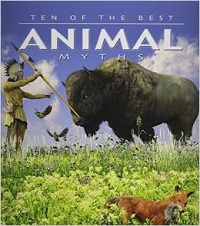| ________________
CM . . .
. Volume XXI Number 30 . . . . April 10, 2015
excerpt:
Ten of the Best Animal Myths is part of a series from Crabtree Publishing that collects various myths in thematic volumes (i.e. Ten of the Best Monster Stories, Ten of the Best Mythical Hero Stories). There are myths here from around the world (Africa, Europe, Asia, North America) that all include, as the title suggests, animals in one form or another. The text of each myth is accompanied by full colour images that help illustrate the stories. On the surface, the book would appear to be a good one for young readers. The book provides, for example, many of the navigation tools we look for in books for emerging readers: table of contents, index, glossary, etc. The inclusion of colour pictures for each story also helps young readers who are trying to better understand complicated diction. Looking closer, however, it is unclear how helpful these elements actually are. The glossary, for instance, is a somewhat arbitrary collection of words from the text. While most of the word definitions (like gourd, lute and Proconsul) would probably help children in elementary school to better understand the stories, some of the others like bragging and mussels are perhaps less necessary, especially when definitions for words like plumage, hurl, erected, ransom and mayhem are left out. Making matters more complicated, at various points definitions are included on the page with the myth, itself, making it unclear where readers should look for clarification. The book is also concerned with telling readers in which part of the world the stories originate. There are three stories that originate from Africa, for instance. The table of contents tells readers that “Anansi the Spider” is “a story from the Ashanti people of Ghana, Africa” but “Why Hippos Don’t Eat Fish” is simply an “African Folktale”, despite the fact that, when readers get to the story, they’re told it’s a myth from the Kikuyu people, “a group of Bantu people that live in Southeast Africa”. The last one “Mainu the Frog” is simply a story from African mythology, with nothing else to suggest a more specific location or cultural origin on that vast continent. The images that are included are also strange. Most of the main pictures for each story are oddly assembled computer generated images that look as though various bits and pieces have been thrown together without much thought given to composition or aesthetic effect. All of the humans are very stilted, as though they have escaped from a video game but once caught in the book are frozen in awkward poses. The cover shot taken from “Wenebjo and Buffalo”, a Native American story embodies much of what doesn’t work about the artwork: the buffalo and the fox look as though they’re taxidermied, the Native American hunter stands awkwardly and appears to have no elbows, and all are arranged in such a way that the viewer’s eye is drawn towards blank spot of wild flower fields at the centre of the page. Discussing each of these shortcomings individually feels nitpicky and unfair, but, taken all together, they contribute to the sense that the book has been rushed and arbitrarily put together. It feels like the book has to adhere to a set of guidelines there needs to be a table of contents and an index, each story should be no more than two pages and should have colour pictures to complement the text, etc. but there is no attempt to ensure that all of these different elements work together to create a pleasing whole that might allow readers to see some of the commonalities behind these myths from different parts of the world. In the end, all of this might be forgiven if the myths and stories, themselves, were compelling and well written. The telling, though, is for the most part perfunctory and superficial with little to engage readers and draw them in to the various tales. The main idea is always there, to be sure, but there’s very little craft or art in the story telling. The Anansi story is emblematic of this; tales of the trickster spider have long captivated the imaginations of listeners and readers fascinated by his daring and reckless behaviour. Readers should be at once swept away by his ingenuity and repelled by his lack of remorse for the consequences of his actions. The best we can say in this case and this is true for virtually all the stories in the collection is that we know the facts and important plot points by the time we get to the end. In a well told myth or folktale, however, the facts and plot points are often among the least important factors to enjoying the story. Not Recommended.
Scott Gordon is a high school librarian and English teacher at Woodrofe High School in Ottawa, ON.
To comment on this title or this review, send mail to cm@umanitoba.ca.
Copyright © the Manitoba Library Association. Reproduction for personal use is permitted only if this copyright notice is maintained. Any
other reproduction is prohibited without permission.
CM Home |
Next Review |
(Table of Contents for This Issue - April 10, 2015.)
| Back Issues | Search | CM Archive
| Profiles Archive |
